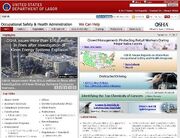
Occupational Safety and Health Administration (OSHA) Screenshot
About[]
The United States Occupational Safety and Health Administration (OSHA) is an agency of the United States Department of Labor. It was created by Congress of the United States under the Occupational Safety and Health Act, signed by President Richard M. Nixon, on December 30, 1970. Its mission is to prevent work-related injuries, illnesses, and occupational fatality by issuing and enforcing standards for workplace safety and health. The agency is headed by a Deputy Assistant Secretary of Labor, of the United States.
The OSHA Act, which created OSHA also created the National Institute for Occupational Safety and Health (NIOSH) as a research agency focusing on occupational health and safety. NIOSH, however, is not a part of the U.S. Department of Labor.
OSHA federal regulations cover most private sector workplaces. The OSHA Act permits states to develop approved plans as long as they cover public sector employees and they provide protection equivalent to that provided under Federal OSHA regulations. In return, a portion of the cost of the approved state program is paid by the federal government. Twenty-two states and territories operate plans covering both the public and private sectors and five — Connecticut, Illinois, New Jersey, New York and the US Virgin Islands — operate public employee only plans. In those five states, private sector employment remains under Federal OSHA jurisdiction.
In 2000, the United States Postal Act made the U.S. Postal Service the only quasi-governmental entity to fall under the purview of OSHA jurisdiction.
History[]
With the Occupational Safety and Health Act of 1970, Congress created the Occupational Safety and Health Administration (OSHA) to ensure safe and healthful working conditions for working men and women by setting and enforcing standards and by providing training, outreach, education and assistance.
The Occupational Safety and Health Act is the primary federal law which governs occupational health and safety in the private sector and federal government in the United States. It was enacted by Congress in 1970 and was signed by President Richard Nixon on December 29, 1970. Its main goal is to ensure that employers provide employees with an environment free from recognized hazards, such as exposure to toxic chemicals, excessive noise levels, mechanical dangers, heat or cold stress, or unsanitary conditions.
The Act can be found in the United States Code at title 29, chapter 15.
Regulatory Impact[]
Here are some of the regulatory changes or impacts made in industrial safety regulation brought about by OSHA:
1. Guards on all moving parts - By 1970, there were guards to prevent inadvertent contact with most moving parts that were accessible in the normal course of operation. With OSHA, use of guards was expanded to cover essentially all parts where contact is possible.
2. Permissible exposure limits (PEL) - Maximum concentrations of chemicals stipulated by regulation for chemicals and dusts. They cover around 600 chemicals. Most are based on standards issued by other organizations in 1968 or before.
3. Personal protective equipment (PPE) - broader use of respirators, gloves, coveralls, and other protective equipment when handling hazardous chemicals; goggles, face shields, ear protection in typical industrial environments
4. Lockout/tagout - In the 1980s, requirements for locking out energy sources (securing them in an "off" condition) when performing repairs or maintenance
5. Confined space - In the 1990s, specific requirements for air sampling and use of a "buddy system" when working inside tanks, manholes, pits, bins, and similar enclosed areas
6. Hazard Communication (HazCom) - Also known as the "Right to Know" standard, was issued as 29CFR1910.1200 on November 25, 1983 (48 FR 53280), requires developing and communicating information on the hazards of chemical products used in the workplace. [1]
7. Process Safety Management (PSM) - Issued in 1992 as 29CFR1910.119 in an attempt to reduce large scale industrial accidents. Although enforcement of the standard has been spotty, its principles have long been widely accepted by the petrochemical industry.[2]
8. Bloodborne Pathogens (BBP) - In 1990, OSHA issued a standard designed to prevent health care (and other) workers from being exposed to bloodborne pathogens such as hepatitis B and HIV. [3]
9. Excavations and Trenches - OSHA regulations specify that trenches and excavations wherein workers are working 5 feet or more down must be provided with safeguards in addition to proper sloping and storage of excavated material in order to prevent collapses/cave-ins. [4]
10. Exposure to asbestos - OSHA has established requirements in 29 CFR 1910.1001 for occupational exposure to asbestos. These requirements apply to most workplaces - most notably excepted is construction work. "Construction work" means work for construction, alteration and/or repair including painting and decorating. Occupational exposure requirements for asbestos in construction work can be found in 29 CFR 1926.1101. [5]
References[]
- ↑ OSHA Hazard Communication Standard 29 CFR 1910.1200
- ↑ OSHA Process Safety Management topic page
- ↑ OSHA Bloodborne Pathogens and Needlestick Prevention topic page
- ↑ OSHA Trench Safety Tips card
- ↑ [1] Safety and Health Regulations for Construction, Toxic and Hazardous Substances: Asbestos, Standard Number: 1926.1101